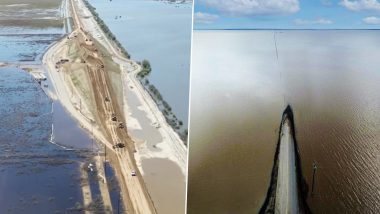Washington, May 23 (AFP) A SpaceX rocket today blasted off a duo of sports car-sized satellites built by the US and Germany to reveal changes in sea level rise, ice melt and drought on Earth.
"Three, two, one, liftoff!" said a SpaceX commentator as the Falcon 9 rocket launched from Vandenberg Air Force Base in California at 12:47 pm Pacific time (1947 GMT).
The USD 521 million payload, called the Gravity Recovery and Climate Experiment Follow-on (GRACE-FO), was successfully deployed into its planned orbit some 500 kilometers above the Earth about 10 minutes after liftoff.
The mission picks up from GRACE, a satellite pair that launched in 2002 and tracked, among other things, precisely how much ice was lost each year in Greenland and Antarctica until 2017.
Groundwater, oceans, lakes, rivers and ice sheets will be monitored by the twin satellites, a joint mission between the US space agency and German Research Centre for Geosciences (GFZ).
The pair will fly 220 kilometers apart, or about the distance from Los Angeles to San Diego.
According to the laws of physics, the slightest variation in mass on Earth modifies the pull of gravity on satellites.
When the lead satellite passes over a mountain, it will get slightly farther from its twin for a few instants because of the extra mass in this area and a slightly stronger pull of gravity.
These variations in distance will be constantly recorded by the spacecraft, because each shift signals a change in mass on the planet underneath.
The satellites use a monthly reference point, because unless there is an earthquake or other unusual event, only water has the capacity to change that fast.
Water always has mass, whether it is in the form of liquid, solid or gas.
When ice melts, the oceans' mass rises. When it rains a lot in a certain region, the volume of the aquifers mounts. The satellites will pick this up, and the data will show that the mass in a certain area was higher than it was in the prior month, or year.
That is how the GRACE-FO satellites will establish a map of the water on Earth, every 30 days, showing which areas have more and which have less, whether above or below ground.
They operate with a precision equivalent to a change of one centimeter in water height across areas of about 340 kilometers in diameter.
After the SpaceX rocket sent off its first payload, GRACE-FO, its second stage continued its climb in order to deploy a series of commercial communications satellites for the Virginia-based company, Iridium.
The five Iridium NEXT satellites are "part of the company's campaign to replace the world's largest commercial satellite network," said a statement.
A total of 75 satellites for Iridium are being sent to orbit as part of the upgrade, taking place over eight launches with SpaceX.
"That is a clean sweep again for all the deployments today," said SpaceX commentator John Insprucker after the five satellites floated into orbit, one by one.
He said SpaceX had tried but failed to catch the payload fairing, a nose cone used to protect the rocket, as it plunged into the ocean.
The fairing recovery ship "came very close but not quite," he said on SpaceX's webcast.
SpaceX did not attempt to land the first stage of the rocket after launch. (AFP) CHT
(This is an unedited and auto-generated story from Syndicated News feed, LatestLY Staff may not have modified or edited the content body)













 Quickly
Quickly




















